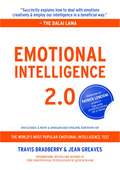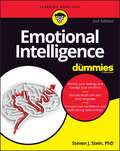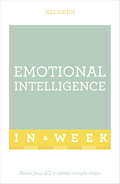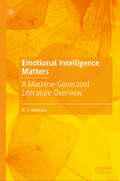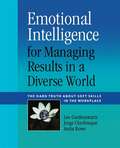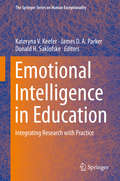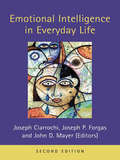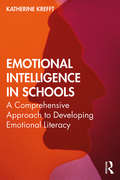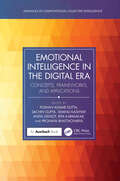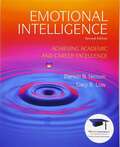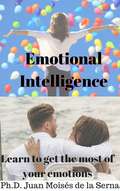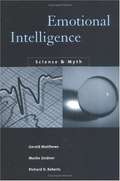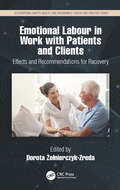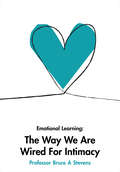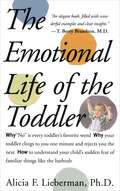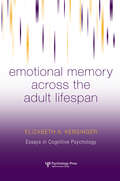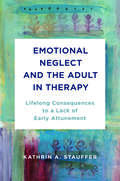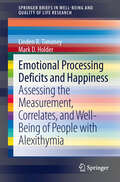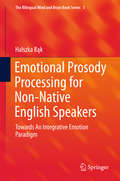- Table View
- List View
Emotional Intelligence
by Christine WildingA TOOLKIT FOR IMPROVING YOUR LIFEEmotional Intelligence is a way of developing a well-balanced thoughtfulness in our lives. The ability to use our thoughts and feelings to change our behaviour and create a positive influence on our surroundings, on our friends and our colleagues, is one which can produce fundamental improvements in our professional and personal lives. It will help us to lift our performance at work, enjoy better relationships and communicate better with those around us.This book combines detailed, practical application of Emotional Intelligence principles along with insights from the fields of mindfulness and positive psychology to create a a powerful tool for change which you can use right away. It presents practical strategies to help you set and achieve new goals either at work or at home, and to engage effectively and positively with everyone around you. ABOUT THE SERIESPeople have been learning with Teach Yourself since 1938. With a vast range of practical, how-to guides covering language learning, lifestyle, hobbies, business, psychology and self-help, there's a Teach Yourself book for whatever you want to do. Join more than 60 million people who have reached their goals with Teach Yourself, and never stop learning.
Emotional Intelligence 2.0
by Travis Bradberry Jean GreavesEmotional Intelligence 2.0 is a book with a single purpose -- increasing your EQ. Here's what people are saying about it: "Emotional Intelligence 2. 0 succinctly explains how to deal with emotions creatively and employ our intelligence in a beneficial way." - The Dalai Lama. "A fast read with compelling anecdotes and good context in which to understand and improve." - Newsweek. "Gives abundant, practical findings and insights with emphasis on how to develop EQ." - Stephen R. Covey. "This book can drastically change the way you think about success...read it twice." - Patrick Lencioni. In today's fast-paced world of competitive workplaces and turbulent economic conditions, each of us is searching for effective tools that can help us to manage, adapt, and strike out ahead of the pack. By now, emotional intelligence (EQ) needs little introduction's no secret that EQ is critical to your success. But knowing what EQ is and knowing how to use it to improve your life are two very different things. Emotional Intelligence 2.0 delivers a step-by-step program for increasing your EQ via four, core EQ skills that enable you to achieve your fullest potential: 1) Self-Awareness; 2) Self-Management; 3) Social Awareness; 4) Relationship Management.
Emotional Intelligence For Dummies (In A Day For Dummies Ser. #77)
by Steven J. SteinGet smart about your feelings to achieve success and happiness Emotional intelligence (also known as emotional quotient or EQ) is all about perceiving, using, understanding, managing, and handling your emotions and those of others. Develop crucial emotional skills that will help you in your career and in your personal life with Emotional Intelligence For Dummies. Learn to manage your emotions, uncover the power of empathy, and build meaningful relationships. Raise emotionally intelligent kids, become a better leader at work, and land the job you want. Let Dummies be your guide to living your best life! Gain emotional awareness that you can use in the workplace and at home Engage in practical exercises to develop your emotional intelligence skills Apply emotional intelligence in parenting children and teenagers Reduce stress and realize greater personal happiness with a higher EQThis new edition incorporates the latest research on emotional intelligence, the new EQ-i 2.0® model, and updated exercises. Anyone who wants to get a grip on their emotions and seek success in life will benefit from this fun and practical guide.
Emotional Intelligence In A Week: Raise Your EQ In Seven Simple Steps
by Jill DannDeveloping your emotional intelligence just got easierExperts are beginning to agree that types of intelligence other than IQ (Intelligence Quotient) have evolved as human capacities over the last two million years. Low Emotional Intelligence Quotient or EQ can be perceived as the absence of control over the outcome of a situation. Do you ever feel like this is the case - you keep getting 'poor luck' or cannot influence better results? When you have a high EQ, you are adept at interpreting the emotional roots of your thinking and behaviours and choosing your actions for beneficial outcomes. You may also be capable of making good insights into the behaviours and reactions of others through empathy and rapport.These topics are explored, step by step in Emotional Intelligence In A Week. You will gain an understanding of EI through finding out about:- Pessimism and optimism- Key milestones in the development of EI-related concepts- Measurement of EQ - a list of assessments - Identifying the benefits of 'emotional fitness'- How EI is learnable- When you get emotionally hijacked- How it will change you- How and why to keep a journal.Over this week-long course, you will cover:- Sunday: Learn how emotional intelligence is relevant to you and how and why there are benefits to developing higher levels.- Monday: Learn how heightened your self-awareness is and the implications on your life currently, for your personal life and as a leader of others.- Tuesday: Learn about the mechanisms of self-control, emotional memory and consciousness to take control of behavioural patterns.- Wednesday: Learn about stress identification and beneficial management strategies.- Thursday: Diagnose and explore change in your organization to create change, manage uncertainty and gain momentum.- Friday: Design and create a new emotionally literate culture, learning environment and a coaching ethos.- Saturday: Learn how to design and tailor successful personal development.
Emotional Intelligence Matters: A Machine-Generated Literature Overview
by R.S. MekhalaThis book is a Machine-Generated Literature Overview of personal EI development. The book is about the importance of developing emotional intelligence in workplace, especially in managing people in an organizational space. It talks about propelling productivity by inducing emotional intelligence. It discusses how stress can be managed with emotional intelligence. The impact of emotional intelligence in developing leadership skills. It explores the role the factor of emotional intelligence in HRM. It critically examines why is it very necessary for an employee to have this trait of EI and develop it eventually for a successful survival. It discusses the importance of EI in customer service and in day-to-day life.
Emotional Intelligence and Leadership Styles: Exploring the Relationship between Emotional Intelligence and Leadership Styles Among Information Technology Professionals
by Eniola Olukayode OlagundoyeAll around the world, information technology is evolving at an alarming rate, and it could be challenging keeping up with the growing changes that we are witnessing with it. This paper explored the relationship between emotional intelligence and leadershi
Emotional Intelligence for Managing Results in a Diverse World: The Hard Truth About Soft Skills in the Workplace
by Anita Rowe Lee Gardenswartz Jorge CherbosqueEncountering generational, cultural, language and behavioral differences in today's global workplace occurs nearly every hour of every day. From here to Dubai or in the conference room down the hall, anger and frustration come easily when others don't do things our way, follow directions, or respond the way we think they should. And when emotions manage workplace relationships, conflict, disengagement and low morale result. Answering the call for fresh insight into what it takes to effectively manage in this complex landscape, Emotional Intelligence for Managing Results in a Diverse World brings together a unique combination - the key principles of emotional intelligence and the fundamentals of diversity and difference. With practical how-tos, action tips, assessment tools and plenty of workplace examples, this cohesive system offers managers, supervisors, team leaders and human resource professionals a proven framework and actionable strategies for developing the critical competencies needed for success: empathy, cross-cultural communication and conflict resolution skills that produce hard results in business. Emotional Intelligence for Managing Results in a Diverse World delivers a proven approach to capturing and using the energy of emotions to bridge difference, turn difficult relationships into satisfying ones and create a healthier workplace and a more effective organization
Emotional Intelligence for Students, Parents, Teachers and School Leaders: A Handbook for the Whole School Community
by Mabel GonzalesThis book heightens readers’ awareness of the importance of emotional intelligence and how it impacts our lives. It inspires parents, teachers and school leaders to learn more about emotional intelligence as a process of self-improvement, relational skills, and to help our students to develop emotional intelligence from an early stage of their lives. There are four parts in the book. Part 1 explains the importance of emotional intelligence in every aspect of our lives. It presents models and theories of emotional intelligence and explains how our emotions control our mind, body and spirit. Part 2 gives insights into how emotions play a significant role in our relationships with others. Part 3 takes the reader from family to the workplace and highlights the importance of becoming more aware of our emotions at work and how we relate to others. Part 4 emphasises the importance of helping our students to develop essential emotional intelligence to face this increasingly complex and challenging world.
Emotional Intelligence in Education: Integrating Research with Practice (The Springer Series on Human Exceptionality)
by James D. Parker Donald H. Saklofske Kateryna V. KeeferThis book highlights current knowledge, best practices, new opportunities, and difficult challenges associated with promoting emotional intelligence (EI) and social-emotional learning (SEL) in educational settings. The volume provides analyses of contemporary EI theories and measurement tools, common principles and barriers in effective EI and SEL programming, typical and atypical developmental considerations, and higher-level institutional and policy implications. It also addresses common critiques of the relevance of EI and discusses the need for greater awareness of sociocultural contexts in assessing and nurturing EI skills. Chapters provide examples of effective EI and SEL programs in pre-school, secondary school, and university contexts, and explore innovative applications of EI such as bullying prevention and athletic training. In addition, chapters explore the implications of EI in postsecondary, professional, and occupational settings, with topics ranging from college success and youth career readiness to EI training for future educators and organizational leaders. Topics featured in this book include: Ability and trait EI and their role in coping with stress, academic attainment, sports performance, and career readiness.Implications of preschoolers’ emotional competence for future success in the classroom.Understanding EI in individuals with exceptionalities.Applications of school-based EI and SEL programs in North America and Europe.Policy recommendations for social-emotional development in schools, colleges and universities.Developing emotional, social, and cognitive competencies in managers during an MBA program.Emotional intelligence training for teachers.Cross-cultural perspective on EI and emotions. Emotional Intelligence in Education is a must-have resource for researchers, professionals, and policymakers as well as graduate students across such disciplines as child and school psychology, social work, and education policy.
Emotional Intelligence in Everyday Life
by John D. Mayer Joseph Ciarrochi Joseph P. ForgasSince the release of the very successful first edition in 2001, the field of emotional intelligence has grown in sophistication and importance. Many new and talented researchers have come into the field and techniques in EI measurement have dramatically increased so that we now know much more about the distinctiveness and utility of the different EI measures. There has also been a dramatic upswing in research that looks at how to teach EI in schools, organizations, and families.In this second edition, leaders in the field present the most up-to-date research on the assessment and use of the emotional intelligence construct. Importantly, this edition expands on the previous by providing greater coverage of emotional intelligence interventions.As with the first edition, this second edition is both scientifically rigorous, yet highly readable and accessible to a non-specialist audience. It will therefore be of value to researchers and practitioners in many disciplines beyond social psychology, including areas of basic research, cognition and emotion, organizational selection, organizational training, education, clinical psychology, and development psychology.
Emotional Intelligence in Schools: A Comprehensive Approach to Developing Emotional Literacy
by Katherine M. KrefftThis text presents a methodical, organized approach to counseling students in emotional intelligence (EI) by detailing how to understand and direct emotions, while also keying counselors directly to the underlying emotional motivations behind the behaviors. Divided into four units, the book starts with an overview of emotions and continues to explore the nature of anger, fear, grief, and guilt. Chapters present both explanatory narratives and teen-centered activities to show how these challenging, uncomfortable feelings when unregulated may negate resiliency and lead to anxiety, bullying, depression, and teen suicide. Counselors and educators alike will benefit from the light, unexacting tone that encourages humor and levity and discusses how to handle difficult emotions without harsh and heavy overtones.
Emotional Intelligence in the Digital Era: Concepts, Frameworks, and Applications (Advances in Computational Collective Intelligence)
by Anita Gehlot Sachin Gupta Pronaya Bhattacharya Pushan Kumar Dutta Shafali Kashyap Rita KarmakarWith research perspectives on elements of psychology and technology, Emotional Intelligence in the Digital Era: Concepts, Frameworks, and Applications provides insight into the intersection of emotional intelligence and digital technologies, including artificial intelligence (AI). It explains how technology has the potential to enhance emotional intelligence and promote positive psychological outcomes. It also discusses the role of technology in facilitating social connections that support mental health and promote self-reflection and personal growth.The main themes explored in the book revolve around understanding human psychology in the context of digital technology in the post-pandemic environment. The book delves into how emotional intelligence plays a crucial role in adapting to virtual environments. It also examines how AI and other digital technologies can enhance engagement and effectiveness. Emphasizing the need for a balanced approach to integrating technology in the field of psychology, the book highlights the potential benefits of technology in promoting emotional intelligence and positive psychological outcomes while also acknowledging the potential risks and ethical considerations associated with its use.Covering such aspects of human psychology as cognitive and emotional processing, personality, motivation, and decision-making, the book discusses the role of technology in improving human psychological perspectives and emotional intelligence, especially within a post-pandemic context. It also examines the use of virtual reality, teletherapy, and other digital tools in mental health interventions. Written for researchers, academics, and mental health professionals, the book is a deep dive into research investigating human psychology, emotional intelligence, and technology.
Emotional Intelligence: Achieving Academic And Career Excellence In College And In Life
by Darwin B. Nelson Gary R. LowKEY BENEFITS: The new second edition of this book provides new students with 13 emotional intelligence skill lessons that will help them excel in both college and in their subsequent careers. KEY TOPICS: This student-centered supplemental text focuses of self-reflection, dialogue, research-based best practices, and emotional assessment so that readers can develop successful emotional learning skills. MARKET: For new students and first-generation students taking courses in Student Success, Career Development, or Foundation Courses.
Emotional Intelligence: Learn to get the most of your emotions
by Juan Moises de la Serna Alexandra JimenezLearn how to get the most out of it. If something has been talked about in recent years in the field of Psychology it has been about Emotional Intelligence, at first as a further development of the area of study of human emotions and their implications in life, to then acquire a predominant role in such important areas as education or business, and all this thanks to the benefits that have been observed that causes both performance and satisfaction with life by those who cultivate Emotional Intelligence. This ebook tries to offer an approximation to the latest research carried out in the field of Emotional Intelligence, where to approach both its definition and consequences, but above all how it can be applied in everyday life in order to obtain the greatest possible benefits. A necessary path, to cultivate the Emotional Intelligence that will be essential once you have finished reading this ebook.
Emotional Intelligence: Science and Myth
by Gerald Matthews Moshe Zeidner Richard D. RobertsEmotional intelligence (EI) is one of the most widely discussed topics in current psychology. Although first mentioned in the professional literature nearly two decades ago, in the past five years it has received extensive media attention.
Emotional Labor in Work with Patients and Clients: Effects and Recommendations for Recovery (Occupational Safety, Health, and Ergonomics)
by Dorota Żołnierczyk-ZredaThis book describes psychosocial working conditions that negatively impact the mental and physical well-being of employees of various “assistance-related” professional groups, as well as individuals whose work is related to contact with demanding clients. It offers concepts and research on the causes and effects of emotional burden (most often manifested as stress and burnout) when working with patients, children, and clients. The book provides a detailed analysis of various aspects of emotional burden at work. It includes a description of studies carried out in 5 different professional groups that were exposed to emotional burden during emotional work and emotional labour. The book discusses the application of known and international diagnostic methods and provides an intercultural comparison. The current diagnosis of stress and burnout, as well as physical and mental health of individuals performing emotional work will be covered, as well as offering practical solutions on assistance for individuals based on the diagnosis of their health. This book is for any professional or aspiring professional in the field, including postgraduate students. Scientists and practitioners in the field of work and health psychology, management, occupational health and safety, and HR will find this book of interest. Employers of assistance and services sectors, authorities formulating employment laws, lawyers, and occupational medicine physicians are also among this book’s top audience.
Emotional Labor in the 21st Century: Diverse Perspectives on Emotion Regulation at Work (Organization and Management Series)
by Deborah E. Rupp Alicia A. Grandey James M. DiefendorfThis book reviews, integrates, and synthesizes research on emotional labor and emotion regulation conducted over the past 30 years. The concept of emotional labor was first proposed by Dr. Arlie Russell Hochschild (1983), who defined it as "the management of feeling to create a publicly observable facial and bodily display" (p. 7) for a wage. A basic assumption of emotional labor theory is that many jobs (e.g., customer service, healthcare, team-based work, management) have interpersonal, and thus emotional, requirements and that well-being and effectiveness in these jobs is determined, in part, by a person’s ability to meet these requirements. Since Hochschild’s initial work, psychologists, sociologists, and management scholars have developed distinct theoretical approaches aimed at expanding and elaborating upon Hochschild’s core ideas. Broadly speaking, emotional labor is the study of how emotion regulation of oneself and others influences social dynamics at work, which has implications for performance and well being in a wide range of occupations and organizational contexts. This book offers researchers and practitioners a review of emotional labor theory and research that integrates the various perspectives into a coherent framework, and proposes an agenda for future research on this increasingly relevant and important topic. The book is divided into 5 main sections, with the first section introducing and defining emotional labor as well as creating a framework for the rest of the book to follow. The second section consists of chapters describing emotional labor theory at different levels of analysis, including the event, person, dyad, and group. The third section illustrates the diversity of emotional labor in distinct occupational contexts: customer service (e.g. restaurant, retail), call centers, and caring work. The fourth section considers broader contextual influences – organizational-, societal-, and cultural-level factors – that modify how and when emotional labor is done. The final section presents a series of ‘reflective essays’ from eminent scholars in the area of emotion and emotion regulation, where they reflect upon the past, present and future of emotion regulation at work.
Emotional Learning: The Way we are Wired for Intimacy
by Bruce A StevensAt last! The secret is out about romantic relationships. Emotional Learning is what we know but lack words to express. Early learning, as an infant or child, reveals 'how we are wired' for intimacy. This book gives practical tips for discovering the script of your unique Emotional Learning, the way it impacts everything important to you and how it might be changed through memory reconsolidation - an important discovery from the neurosciences. Insights from Schema Therapy and Coherence Therapy are conveyed with helpful clinical examples and clear therapeutic principles. It may surprise you but this book delivers more than it promises.
Emotional Life of the Toddler
by Alicia F. LiebermanAny parent who has followed an active toddler around for a day knows that a child of this age is a whirlwind of explosive, contradictory, and ever-changing emotions. Many books cover the physical and cognitive abilities of the toddler, but Lieberman's is the first to offer an in-depth examination of the varied and intense emotional life of children from ages one to three. Drawing on her lifelong research, Dr. Lieberman addresses commonly asked questions and issues. Why, for example, is "no" often the favorite response of the toddler? How should parents deal with the anger they sometimes feel in the face of their toddler's unflagging obstinacy? Why does a crying toddler run to his mother for a hug only to push himself vigorously away as soon as she begins to embrace him? With the help of numerous examples and vivid cases, Lieberman answers these and other questions, giving us, in the process, a rich, insightful profile of the roller coaster emotional world of the toddler. Lieberman shows that the toddler is torn between the strong desire to remain close to the parent and the equally compelling drive to explore new and exciting surroundings. The author discusses how a child can be helped to achieve a balance between these conflicting desires, to feel both confident and outgoing as well as protected and comforted when necessary. Lieberman also provides fascinating new material on how children's different temperaments express themselves during the toddler years and how parents can better match their own temperaments to their child's. Particular attention is given to the shy child and the very active child at this age. In addition, Lieberman gives new insights on how best to handle common toddler problems, such as sleep disturbances, sibling rivalry, and temper tantrums. She also provides invaluable information on the normal anxieties of this age and how to recognize when anxiety is excessive, needing special attention. Finally, she gives us a fresh, insightful picture of how toddlers typically handle the stress of their parents divorce and outside child care, and provides sensitive practical advice on easing the toddler through these transitions. The Emotional Life of the Toddler is an invaluable resource for parents, clinicians, researchers, and child-care workers alike.
Emotional Literacy in Criminal Justice
by Charlotte KnightEmotions remain largely invisible in the management of criminal justice practice. This book seeks to uncover some of the underground emotional work of practitioners and make visible the impact of both positive and negative emotions, which play a crucial role in practitioner-offender relationships. Exploring how practitioners understand, regulate and work with emotion, Knight argues that the 'soft skills' of emotion are more likely to achieve motivation and change in offenders than the 'hard' skills of punishment, monitoring and surveillance. The book examines some of the gendered implications of this practice and develops an argument for the explicit building of emotional resources within organizations to sustain the development, enhancement and support of emotional literacy in the workforce. Using practice examples, Knight reveals how practitioners can benefit from having an understanding of their own emotions and how these can impact on their practice. This unique and accessible book will be a valuable resource to practitioners across the criminal justice sector including probation officers, youth justice workers, police and prison officers, social workers, policymakers and managers, as well as scholars working within criminology, criminal justice and probation.
Emotional Memory Across the Adult Lifespan (Essays in Cognitive Psychology)
by Elizabeth A. KensingerThough many factors can influence the likelihood that we remember a past experience, one critical determinant is whether the experience caused us to have an emotional response. Emotional experiences are more likely to be remembered than nonemotional ones, and over the past couple of decades there has been an increased interest in understanding how emotion conveys this memory benefit. This book begins with a broad overview of emotion, memory, and the neural underpinnings of each, providing the reader with an appreciation of the complex interplay between emotion and memory. It then examines how emotion influences young adults’ abilities to store information temporarily, or over the long term. It explains emotion’s influence on the memory processes that young adults use consciously and on the processes that guide young adults’ preferences and actions without their awareness. This book then moves on to describe how each of these influences of emotion are affected by the aging process, and by age-related disease, providing the reader with a lifespan perspective of emotional memory. Within each of the domains covered, the book integrates research from cognitive psychology, cognitive neuroscience, and neuropsychological perspectives, examining both the behavioral and thought processes that lead to emotion’s effects on memory and also the underlying brain processes that guide those influences of emotion. This book will be of interest to researchers and graduate students in memory, emotion, and aging, working in the fields of cognitive psychology, cognitive or affective neuroscience, and developmental or lifespan psychology.
Emotional Neglect and the Adult in Therapy: Lifelong Consequences To A Lack Of Early Attunement
by Kathrin A. StaufferA clinical examination of the ways in which early neglect can impact adults throughout their lives, and suggestions for therapists on how to help. People who have experienced emotional neglect in the first months and years of life suffer negative consequences into adulthood. As adult psychotherapy clients, they require long-term work and delicate emotional attunement as well as a profound understanding of the experiences that have shaped their inner worlds. This book provides therapists with an in-depth view of the subjective experience of such “ignored children” and a range of possible theoretical models to help understand key features of their psychological functioning. Kathrin A. Stauffer presents do’s and don’t’s of psychotherapy with such clients. She draws on broad clinical experience to help psychotherapeutic professionals deepen their understanding of “ignored children” and outlines available neurobiological and psychological data to assist therapists in designing effective therapeutic interventions.
Emotional Presence in Psychoanalysis: Theory and Clinical Applications
by John MadonnaEmotional Presence in Psychoanalysis provides a detailed look at the intricacies of attaining emotional presence in psychoanalytic work. John Madonna and a distinguished group of contributors draw on both the relational and modern psychoanalytic schools of thought to examine a variety of different problems commonly experienced in achieving emotional resonance between analyst and patient, setting out ways in which such difficulties may be overcome in psychoanalytic treatment, practical clinical settings and in training contexts. A focused review of relevant comparative literature is followed by chapters featuring individual clinical case studies, each illustrating particularly challenging aspects. The uniqueness of this book lays not simply in the espousal of the commonly accepted importance of emotional resonance between analyst and patient; rather it is in the way in which emotional presence is registered by both participants, requiring a working through, which at times can be not only difficult but dangerous. Such efforts involve a theory which enables the lens to understanding, an effective methodology which guides intervention. The book also calls for the art of the analyst to construct with patients meanings which heal, and possess the heart to persist in commitment despite the odds. Emotional Presence in Psychoanalysis is about patients who suffer, struggle, resist and prevail. It offers distinctive, transparently told accounts of analysts who engage with patients, navigating through states of confusion, hatred and more controversial feelings of love. Emotional Presence in Psychoanalysis features highly compelling material written in an accessible and easily understood style. It will be a valuable resource for psychoanalysts and psychoanalytic psychotherapists, psychologists and clinical social workers as well as teachers, trainers and students seeking to understand the power and potential of the analytic process and the resistances to it.
Emotional Processing Deficits and Happiness: Assessing the Measurement, Correlates, and Well-Being of People with Alexithymia
by Mark D. Holder Linden R. TimoneyThis briefs reviews the literature on alexithymia with a particular focus on the relation between positive well-being and alexithymia. It starts by exploring the definition, history and etiology of the construct. The briefs then discusses the importance of research and presents new research which sheds light on why alexithymia is characterized by poor well-being. The research strongly suggests that people who score high in alexithymia are low in aspects of positive well-being such as happiness, life satisfaction, and positive affect, and high in aspects of negative well-being, such as depression and negative affect. Next, the book examines the correlates of alexithymia and the latter's relation with personality and subjective well-being. Although there has been an increased interest in human flourishing, and even though research in positive psychology has included personality, there has been little application of positive psychology to people with deficits in emotional processing including people with alexithymia. This briefs fills that gap.
Emotional Prosody Processing for Non-Native English Speakers
by Halszka BąkThis volume provides the first systematic and data-driven exploration of English emotional prosody processing in the minds of non-native speakers of the language. Over the past few decades emotional prosody has attracted the interest of researchers from a variety of disciplines such as psychiatry, neuropsychology, psycholinguistics, and linguistics. Although a considerable collective body of empirical evidence exists regarding emotional prosody processing in native speakers of various languages, non-native speakers have been virtually ignored. This constitutes a knowledge gap of increasing relevance, as we approach 2050, the year when the global population of non-native speakers of English is estimated to overtake that of native speakers of the language. This volume aims to fill this gap and provide insights into how emotions are processed on multiple levels while also presenting novel methodological solutions. Crucially, "Emotional Prosody Processing for Non-Native English Speakers: Towards an Integrative Emotion Paradigm" begins by providing a conceptual background of emotion research, and then demonstrates a novel, workable, completely integrative paradigm for emotion research. This integrative approach reconciles theories such as the dimensional view of emotions, the standard basic emotions view, and the appraisal view of emotions. Following this theoretical section is an empirical exploration of the topic: the volume explores those views via experimental tasks. The insight into overall processing such a multiple-level approach allows a comprehensive answer to the question of how non native speakers of English process emotional prosody in their second language. By offering a critical, data-driven, integrative approach to investigating emotions in the minds of non-native English speakers, this volume is a significant and timely contribution to the literature on emotion prosody processing, bilingual research, and broadly understood emotion research.

